
views
Developing the Melody

Experiment with different progressions to find your main chords. A chorus is usually comprised of 4 or more chords that make up a progression. Before you can write the chorus, you must make sure the melody of the music is interesting and catchy. Experiment with playing a different series of notes until you discover the main notes for your chorus. You can use any instrument of your choice to produce the music for your song including but not limited to, guitar, piano, or music software. Popular chord progressions include G – D – Em – C, G – Em – C – D, G – D – Em – Bm – C – G – C – D, and D – C – G – D.
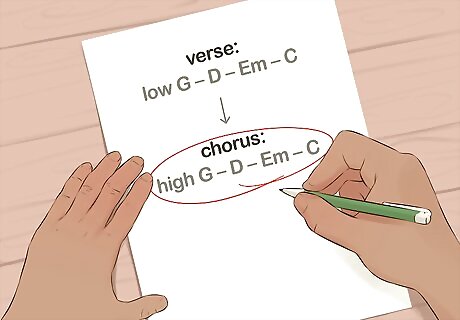
Make the melody of the chorus in a higher note than the verses. If the notes in the chorus are higher than they are in the first verse, it will make the chorus stand out more. Play the notes in the chorus in a higher octave than the notes in the verse to give the chorus portion more impact. For instance, the left-most key in a piano is a C note but the 8th key from the left-most key is also a C in a higher octave. For example, if the music during the verse is a low G – D – Em – C, you can play the same notes for the chorus but in a higher octave.

Create a repeating pattern to create a motif. A motif is a repeating pattern in the melody of the song and helps with making the music more catchy. The pattern doesn’t have to be in the same notes and can be in a slightly different tempo to create some variation, but the core melody should stay intact. It’s best to create motifs to make your chorus more catchy. For example, a motif could be whole note-half note-whole note-quarter note. You can change the note of each beat, but keeping the same rhythm will create a motif in your melody.

Cut portions of the music right before the chorus starts for impact. If you scale back the number of instruments playing simultaneously right before the chorus hits, it will give the chorus more impact. Many times in hip-hop this includes removing some portion of the drums. In rock, it might be removing the lead and rhythm guitars. Experiment with different ways to scale back the production to highlight the chorus. In electronic music, this lull before the main portion of the song is often called “the drop.”
Setting the Structure of the Chorus

Hum the vocal melody while listening to the music. Turn off everything around you and listen to the music in your song. When you get to the chorus, hum in rhythm to create a vocal melody. Change the pitch of your hum to determine which octave and notes to use. Use trial and error until you get a vocal melody you like. The vocal melody can go along or greatly differ from the melody of the music.
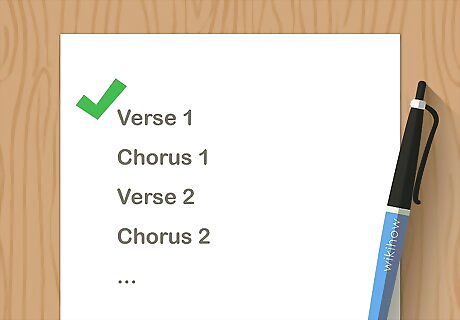
Place the chorus after the verse for a traditional format. The verses are more detailed parts of the song while the chorus should be catchiest part. For many songs, the song will go verse-chorus-second verse-chorus. While you don’t have to stick to this format, it may make it easier if you’re just new to writing your own music. When a chorus is only made of 1 or 2 lines, it’s called a refrain.

Sing a chorus that lasts 30-60 seconds. Usually, a chorus is anywhere from 6-12 lines long. Most of the most popular choruses in history were 30-60 seconds long. This length ensures that the chorus isn't too long but is long enough to be memorable.
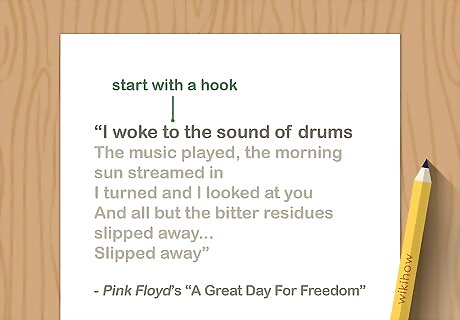
Put a hook in the chorus to make it more catchy. A hook is 1 or 2 lines from your song that are memorable and catchy. Many times the hook can be found in the chorus of the song but can also be found in the intro and outro of a song. Consider adding a repetitive 1 or 2 lines in your music. EXPERT TIP Halle Payne Halle Payne Singer/Songwriter Halle Payne has been writing songs since the age of eight. She has written hundreds of songs for guitar and piano, some of which are recorded and available on her Soundcloud or Youtube channel. Most recently, Halle was a part of a 15-person collaboration in Stockholm, Sweden, called the Skål Sisters. Halle Payne Halle Payne Singer/Songwriter Repetition is your best friend. Most great songs, especially in the top 40, utilize the power of a "hook." Halle Payne, Singer/Songwriter, adds: "This can be a phrase, a word, or even meaningless sounds! Think "Ob-la-di Ob-la-da" by the Beatles, or "Gimme! Gimme! Gimme!" by ABBA. Three times repeated is the charm."
Writing the Lyrics
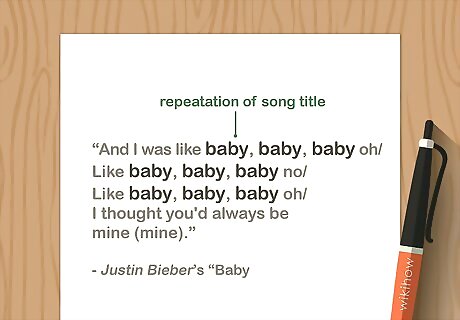
Repeat the song title in the chorus to make the song catchy and memorable. Repeating the title will also help people look up the title of your song since they’ll likely remember the lyrics of the chorus. Consider using the title of your song in conjunction with the melody you created to create a catchy chorus. For example, Justin Bieber’s song “Baby” goes like, “And I was like baby, baby, baby oh/Like baby, baby, baby no/Like baby, baby, baby oh/I thought you'd always be mine (mine).”
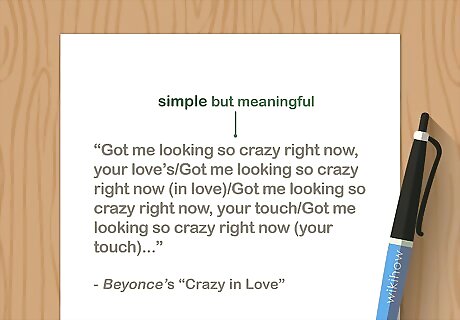
Keep the lyrics of the chorus simple so people can memorize it. Keep the chorus simple but meaningful so that people can memorize it and sing along. The more complex your chorus is, the harder it will be for people to memorize and relate to it. For instance, “Shake it Out” by Florence + the Machine goes, “Shake it out, shake it out/Shake it out, shake it out, ooh whoa/Shake it out, shake it out,/Shake it out, shake it out, ooh whoa/And it's hard to dance with a devil on your back/So shake him off, oh whoa.” Another example of a simple chorus is Beyonce’s “Crazy in Love” which goes like, “Got me looking so crazy right now, your love's/Got me looking so crazy right now (in love)/Got me looking so crazy right now, your touch/Got me looking so crazy right now (your touch)...”
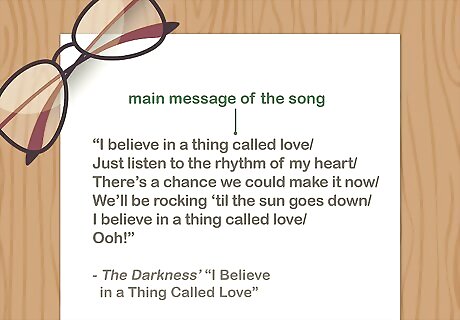
Convey the main message of the song in the chorus. The verses should have more fine detail while the chorus should contain the main message of the song. Think about what you want to convey and sing it in the chorus. For example, if the song is about the pain you feel after a breakup, the chorus should include something about your emotional state. For example, in The Darkness’ song “I Believe in a Thing Called Love” the chorus goes, “I believe in a thing called love/Just listen to the rhythm of my heart/There's a chance we could make it now/We'll be rocking 'til the sun goes down/I believe in a thing called love/Ooh!”
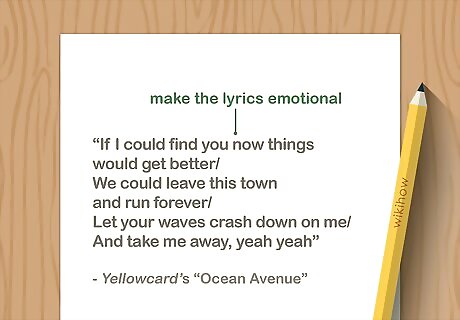
Try to make the lyrics emotional and moving for more impact. Listeners are more likely to remember your chorus if they can relate to it on an emotional level. Think of lyrics that tug at the heart strings to make it more memorable for your listeners. For example, Yellowcard’s “Ocean Avenue” goes,“If I could find you now things would get better/We could leave this town and run forever/Let your waves crash down on me/And take me away, yeah yeah,” which depicts the singer’s strong feelings for someone.
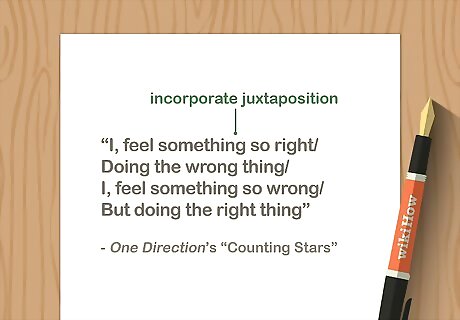
Incorporate juxtaposition to make the lyrics interesting. Juxtaposition is a literary contradiction, like, “It feels so good to be so bad.” This device is used regularly in popular choruses. Think of ways you can use contradictory statements to create unique wording for your chorus. For example, One Direction’s “Counting Stars” goes “I, feel something so right/Doing the wrong thing/I, feel something so wrong/But doing the right thing.”
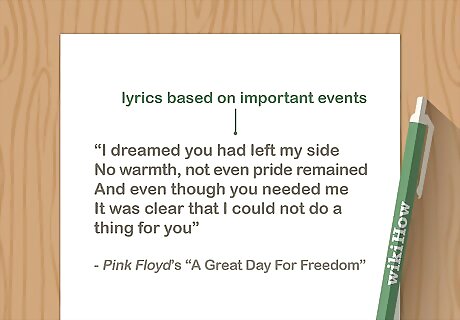
Write lyrics based on important events in your life. A sense of authenticity may draw people to your music and lyrics. Think of important moments in your life and try to incorporate those moments into your music. If you can’t think of anything interesting from your own life, you can even write music about historical events that have happened. For example, "A Great Day For Freedom" by Pink Floyd is about the collapse of the Berlin Wall.











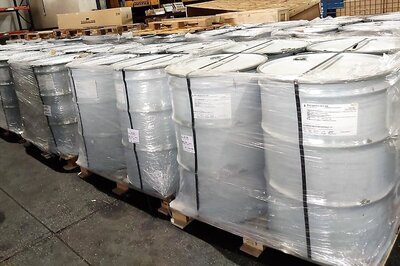




Comments
0 comment